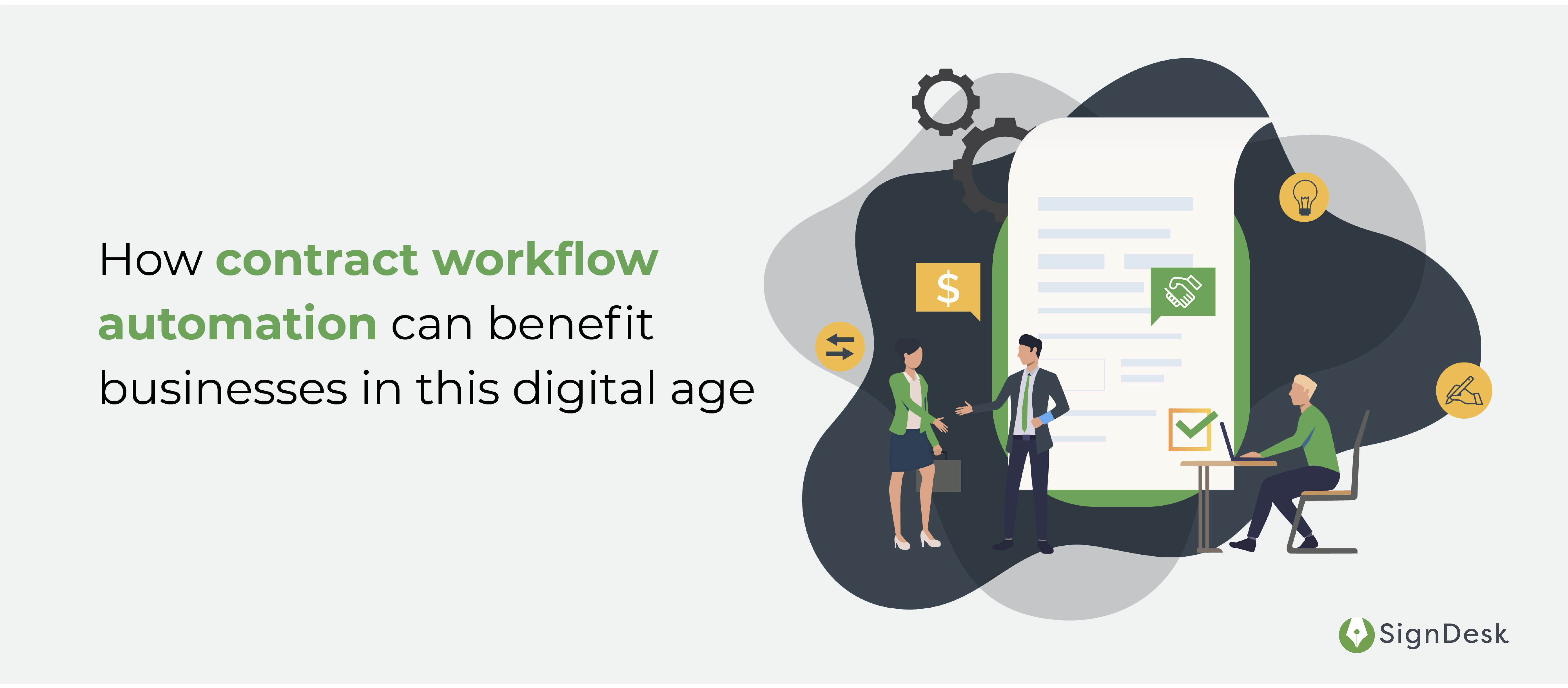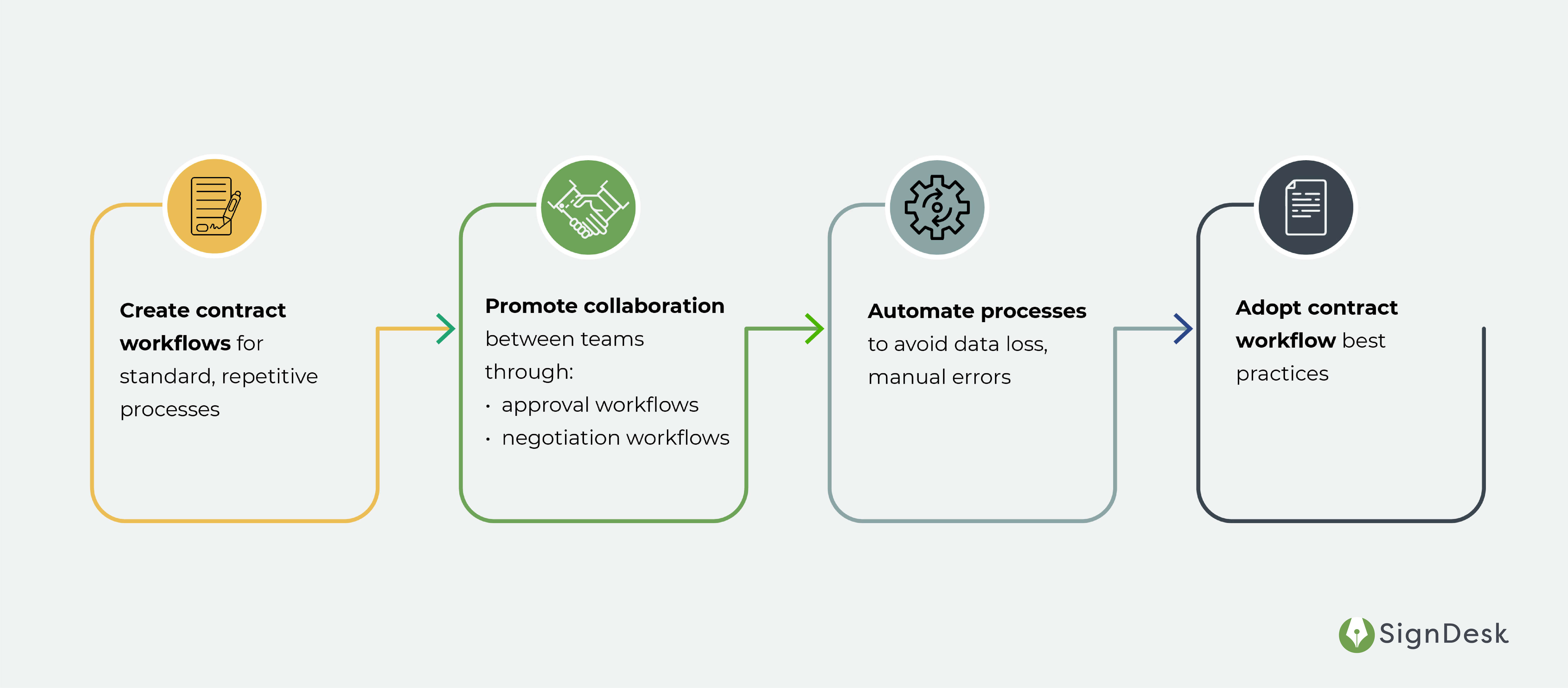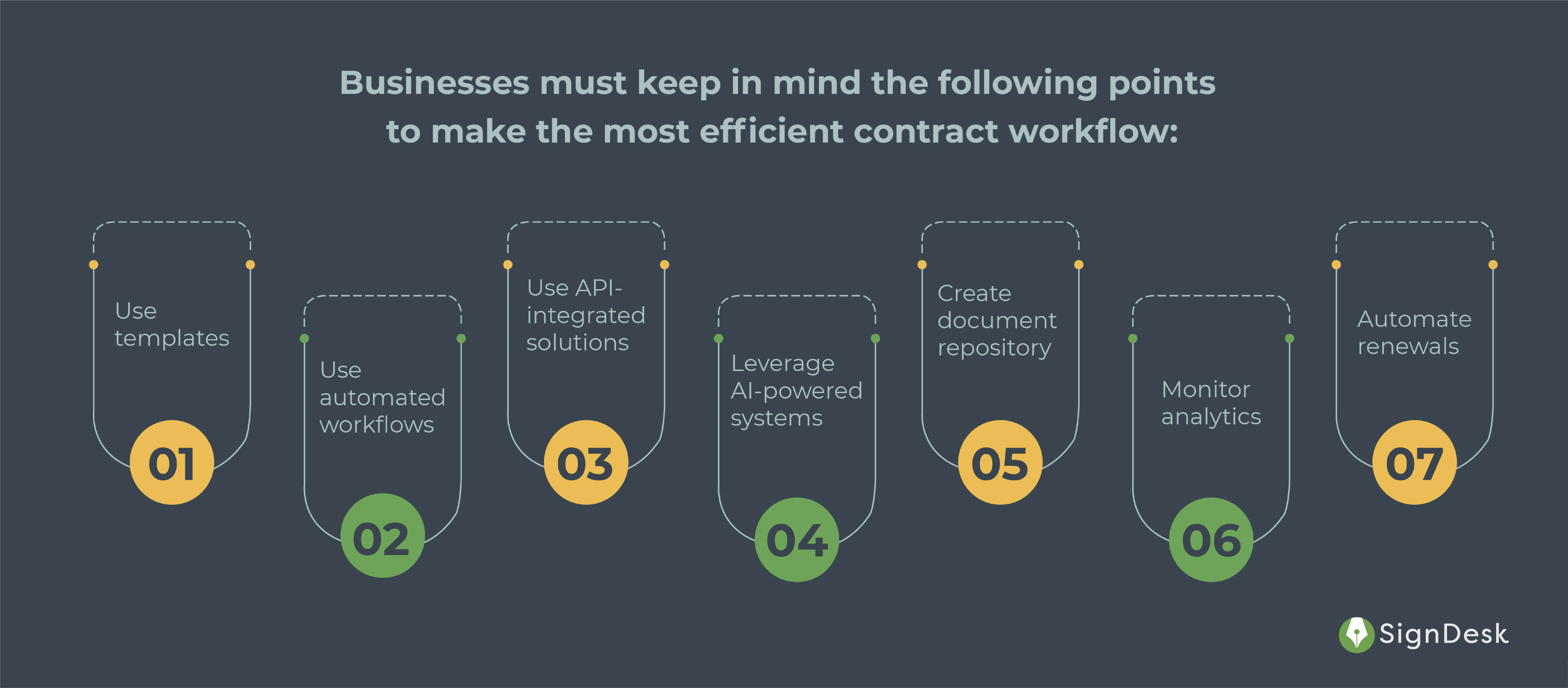
Contracts are more than just words on a page. These documents set the wheels in
motion and hold businesses and their clients accountable for sticking to commitments. They affect more than just the people at the negotiating table. Given the significance of contracts to businesses, the contractual process must be an efficient one. To improve the efficiency of contracts, it is essential to understand contract workflows and the different challenges businesses face while implementing them.
In simple terms, a contract workflow is an end-to-end process of getting a legal document through various stages from initiation to execution, renewal, etc. Contract automation streamlines this process.
Stages of a contract workflow
A contract workflow can be divided into seven steps:
- Initiation: This step puts the contract workflow into motion.
- Drafting: After receiving the request, the contract is drafted from a precedent or standard form document.
- Negotiation: At this stage, various parties go back and forth to align themselves on a defined set of terms and conditions.
- Approval: After the negotiations, all the required team members proceed with the approvals based on hierarchy.
- Signing: Signing the contract is the final stage that binds the parties to the agreement.
- Performance: At this stage, parties comply with all the terms and conditions of the contract and failure to do so makes them liable for penalties as per the contract.
- Renewal: Involved parties can revisit or renegotiate the original contract stored in the repository through contract review. They can also renew expired contracts.
Challenges faced during the workflow process
The challenges faced by most businesses using a contract workflow are similar, if not the same. The most common challenges are outlined below:
- Standardization: Lack of standardization and templatization results in duplication of work and increased man-hours in drafting the same contracts. It also leads to human errors caused while manually drafting the contract.
- Status and Review: Due to the multiple teams and stakeholders involved in the contractual process, it becomes difficult to track the status of the contract and where it is currently stuck for review or approval.
- Time: Sometimes, legal teams take much longer to draft contracts that pass all checks. The back and forth communication via emails for negotiations and approvals also results in a waste of time and data inconsistency. Lastly, physical signatures and stamp paperwork are tedious and time-consuming, too. The availability of authorized signatories further stretches the time taken for a contract to be approved and signed seamlessly.
- Security: Security breaches in the contract process are high up in the list of concerns due to improper storage of documents and lack of accountability by authorized personnel in a company.
- Missed Renewals: As the legal team is responsible for multiple tasks, contracts that are nearing expiration are not renewed on time. It is also difficult to remember and keep track of multiple contracts and their renewal dates.
- Improper Storage: The absence of a unified, digital storage repository leads to misplaced contracts and related documents thereby resulting in a consequent loss of enterprise information. It also causes a loss of productivity due to the team’s inability to retrieve documents at a given time.
Overcoming challenges and improving efficiency

Let’s take a look at different business teams and the key areas to focus on to overcome contract workflow challenges:
Human Resources
- HR teams work endlessly on drafting contracts and policies for new joinees, current employees, exit formalities, and other such functions.
- HR contracts also require the involvement of the legal teams to approve the terms, in addition to the final approval required from the respective team members.
- The collaborative nature of HR contracts means it is important to have a frictionless contract workflow solution to create and manage them, to make sure that no team becomes the bottleneck for hiring new employees or drafting new policies.
Legal
- The legal team needs to frequently assess risks, ensure the organization’s security, which makes it difficult for them to embrace wide-scale change.
- Legal contract workflow must enable members to save time on repetitive tasks and focus on value addition.
- They must focus on running processes smoothly by replacing manual tasks such as drafting, negotiation, and contract renewal with automated processes.
- Adopting legal contract workflow solutions broadens the reach of legal departments, allowing knowledge to be shared effectively and expertise silos to be avoided.
- In addition to this, the use of standardized templates and contracts promotes risk mitigation and awareness of best practices with legal compliance.
Finance
- Finance teams are responsible for various important functions of a business – vendor contracts, employee salaries, audits, business contracts, etc.
- They work on a collaborative level with HR, legal and other teams on these contracts. Therefore, they must work on adopting contract workflow solutions and reduce the dependency on human resources.
- This also helps them to focus on minimizing discrepancies caused due to manual errors and improve efficiency.
- Seamless collaboration is the key to receiving timely status updates, approvals, reviews, and signatures on contracts.
Operations
- The operations team works on a collaborative level with various departments across the business.
- To ensure a seamless flow of approvals and to track status reviews effortlessly, it is important to set up an approval workflow that assigns approval roles to the required team members.
- Using such workflow solutions to streamline all operational processes enables the team to focus on high-value tasks and save time and effort on manual, repetitive ones.
Making the most efficient contract workflow
When it comes to making contract workflows more efficient, automation is key. Digitizing operational processes is the way forward for businesses, with a large number of organizations already taking the necessary steps towards automation and optimization. Teams can automate most of the steps in a contract with contract workflow automation, thereby enhancing the efficiency of the entire process and freeing up time for in-house legal teams and other team members.
Here are some key points for businesses to optimize their performance, as per :
1. Set up templates: The HR, legal, and finance teams can define the terms of the master contracts from which other team members can create offer letters, vendor contracts, and so on.
2. Set up automated workflows: Partner with contract workflow automation specialists like SignDesk to create automated contract workflows that track approvals, review status, and make the contract process more collaborative. Low code automation can be used to simplify the process, making it easy to set up workflows without requiring extensive coding skills.
Automation of HR contracts reduces time spent on paperwork by 75%. By automating tasks such as sending out purchase orders and updating payment status, finance teams can spend their time optimizing operations and budgets using low-code automation to streamline these processes efficiently.
3. Use API-integrated solutions: Using API-integrated solutions such as CLM software, eSign and eStamp enable businesses to electronically sign contracts and avoid the hassle of stamp paperwork. This saves time spent waiting for physical signatures and stamp paper.
Integrating SignDesk’s API with a business’s existing tools and systems allows a seamless flow of information. It helps the team to keep track of the contract status and say goodbye to toggling back and forth between spreadsheets and email threads.
4. Leverage AI systems: AI-powered contract workflow tools allow businesses to streamline their processes by monitoring workflows to identify the number of days taken by the team to complete tasks and suggest new timelines to increase productivity. AI-powered workflows also analyze risks and issues in the contracts and suggest risk mitigation methods.
5. Create a document repository: Using technology to automate your contract workflow helps you to store all contracts and related information in one place. This prevents loss of data, errors caused due to human intervention and alleviates security concerns.
6. Monitor analytics: Regardless of how diligent a business’s contract workflow is, they may still encounter bottlenecks. Monitoring data insights of your contract workflow system helps a business to identify any challenges or risks in their current workflow and mitigate them.
7. Automate renewal reminders: Use workflow automation to set up custom renewal reminders to track key contract renewal dates. Once the reminder is set for a particular date, the relevant stakeholders will get an automated reminder email to let them know the contract is renewing soon.

In conclusion, contract workflow management, including contract automation, is an important part of any organization’s performance. All teams must communicate and collaborate effectively for the process to run smoothly. In this digital era, automated workflows are important to save time, reduce turnaround time, and improve efficiency.